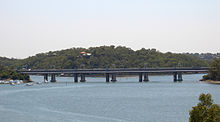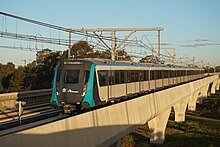
The City Circle is a mostly-underground railway line located in the Sydney central business district and Haymarket, in New South Wales, Australia, that forms the core of Sydney's passenger rail network. The lines are owned by the Transport Asset Holding Entity, a State government agency, and operated under Transport for NSW's Sydney Trains brand. Despite its name, the City Circle is of a horseshoe shape, with trains operating in a U-shaped pattern. The constituent stations of the Circle are (clockwise): Central, Town Hall, Wynyard, Circular Quay, St James, Museum and back to Central.

Sutherland is a city in southern Sydney, in the state of New South Wales, Australia. Sutherland is located 26 kilometres south of the Sydney central business district and is the administrative centre for the local government area of the Sutherland Shire.

Bondi Junction railway station is located on the Eastern Suburbs line, serving the Sydney suburb of Bondi Junction in the Australian state of New South Wales. It is served by Sydney Trains T4 Eastern Suburbs & Illawarra Line services and NSW TrainLink South Coast Line services.

The Eastern Suburbs Railway (ESR) is a commuter railway line in Sydney constructed in the 1970s. It is operated by Sydney Trains and has stations at Martin Place, Kings Cross, Edgecliff and Bondi Junction. In addition, it has dedicated platforms at Town Hall, Central and Redfern stations. All of these stations are underground. The Eastern Suburbs railway connects with the Illawarra line at Erskineville, forming the Eastern Suburbs & Illawarra Line. The line features turnbacks at Central, Martin Place and Bondi Junction. There was also previously a rarely used cross-over at Edgecliff. It operates a service every 3 to 5 minutes during weekday peak hours and 8 to 10 minutes at all other times.
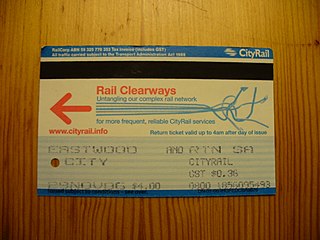
The Rail Clearways Programme was conceived in 2004 with the aim of easing congestion of Sydney's suburban railway network, by reducing the amount of infrastructure shared by multiple services. The disparate projects at pinch points throughout the network were designed to increase passenger capacity and improve reliability. All projects were delivered by the Transport Construction Authority until it was subsumed in November 2011 by Transport for New South Wales. A new timetable was introduced in October 2013 that realised the benefit of many of the projects, and by January 2014—the programme was complete.

Waterfall railway station is located on the Illawarra line, serving the Sydney suburb of Waterfall. It is served by Sydney Trains T4 Illawarra line services and NSW TrainLink South Coast Line services.

The South Coast Railway is a commuter and goods railway line from Sydney to Wollongong and Bomaderry in New South Wales, Australia. Beginning at the Illawarra Junction, the line services the Illawarra and South Coast regions of New South Wales.

Loftus railway station is located on the Illawarra line, serving the Sydney suburb of Loftus. It is served by Sydney Trains T4 line services and limited NSW TrainLink South Coast line services.

Allawah railway station is located on the Illawarra line, serving the Sydney suburb of Allawah. It is served by Sydney Trains T4 line services.

Banksia railway station is located on the Illawarra line, serving the Sydney suburb of Banksia. It is served by Sydney Trains T4 line services.

The South Coast Line (SCO) is an intercity rail service operated by NSW TrainLink that services the Illawarra region of New South Wales, Australia. The service runs from Central, and runs the entire length of the eponymous South Coast railway line to Bomaderry. The service also runs along the Eastern Suburbs railway line at peak hours and the Port Kembla railway line to Port Kembla. It is operated with NSW TrainLink H sets and Sydney Trains T sets, with Endeavour railcars operating the service on the non-electrified line between Kiama and Bomaderry.

Hurstville railway station is located on the Illawarra line, serving the Sydney suburb of Hurstville. It is served by Sydney Trains T4 line services and NSW TrainLink South Coast line services.

Woolooware is a suburb in southern Sydney, in the state of New South Wales, Australia. Woolooware is located 24 kilometres (15 mi) south of the Sydney central business district in the Sutherland Shire. It shares the 2230 postcode with Cronulla.

Burraneer is a bayside suburb in southern Sydney, in the state of New South Wales, Australia. Burraneer is 26 kilometres south of the Sydney central business district, in the local government area of the Sutherland Shire.
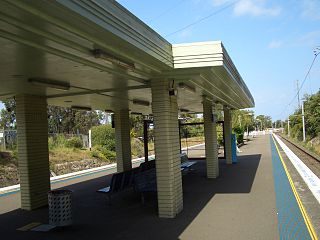
Caringbah railway station is located on the Cronulla line, serving the Sydney suburb of Caringbah. It is served by Sydney Trains T4 line services.
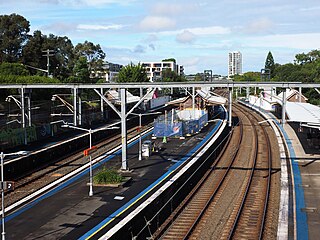
Erskineville railway station is located on the Illawarra line, serving the Sydney suburb of Erskineville. It is served by Sydney Trains T3 Bankstown line services.

Sutherland railway station is located on the Illawarra line, serving the Sydney suburb of Sutherland. It is served by Sydney Trains T4 line services and NSW TrainLink South Coast line services.

Sydney, the largest city in Australia, has an extensive network of passenger and freight railways. The passenger system includes an extensive suburban railway network, operated by Sydney Trains, a metro network and a light rail network. A dedicated freight network also exists. Future expansion of the light rail network includes the Parramatta Light Rail. Existing light rail services are the Inner West Light Rail and the CBD & South East Light Rail.
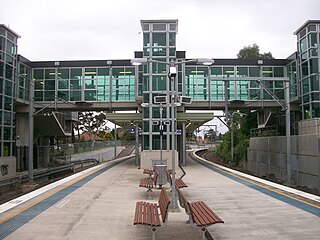
The Cronulla railway line is a suburban branch line serving the southern suburbs of Sydney, New South Wales, Australia. Sydney Trains operates electric passenger train services over the line as part of its Eastern Suburbs & Illawarra Line.
Various railway lines have been proposed for Sydney, Australia, including both heavy rail extensions to the existing network, and more recently proposals for metro style lines–one of which was completed in 2019.





